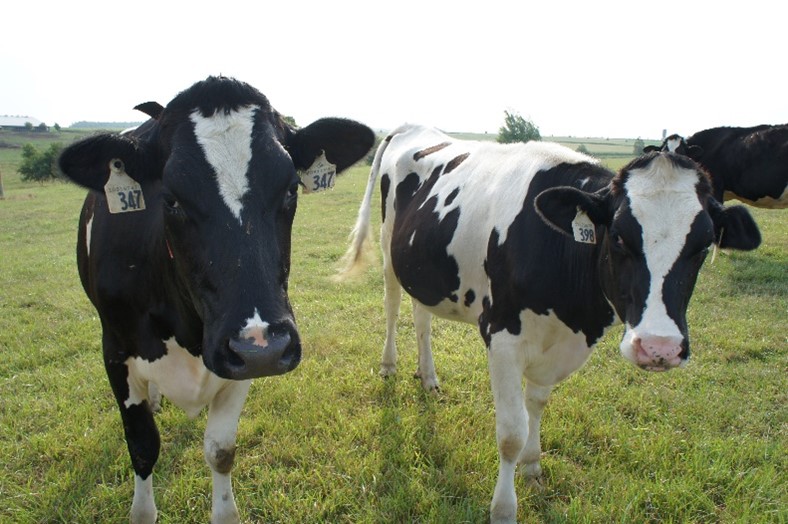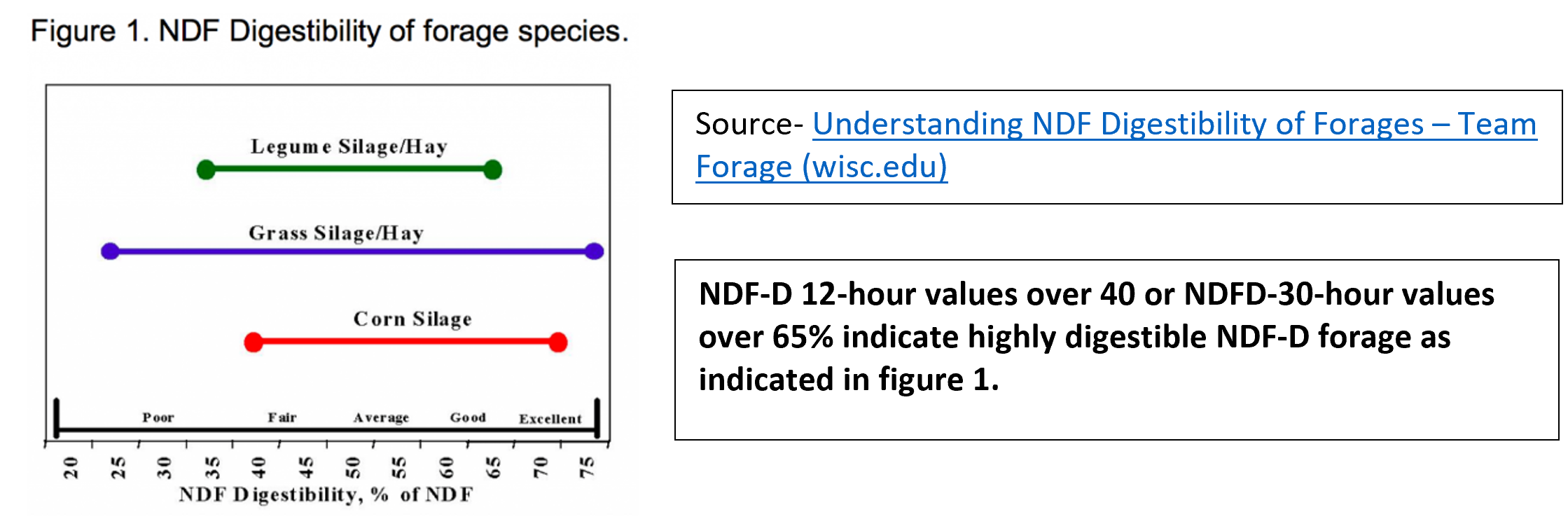NDF Digestibility
With the forage harvest year over, dairy farmers and their nutritionists are now taking stock and assessing the quality of silage that has been harvested and stored for feeding the dairy herd this fall and into 2024. For dairy farmers who have or will soon be planning their 2024 crop rotation and ordering forage seed, it’s also a great time to evaluate their forage seedings in terms of what has been working and where there may be an opportunity to do better.
Forages are a big part of dairy diets and highly digestible alfalfa, and grass forages can maintain or increase milk yields and fat corrected milk production by providing a fermentable substrate for the rumen microbes. Microbial fermentation produces volatile fatty acids which are the end product from the fermentation of cellulose fibers and other sugars. Volatile fatty acids (VFA’s) produced in the rumen are used as the major energy source for the cow for the synthesis of milk fats known as triglycerides and milk sugars, mainly lactose. VFA’s can provide up to 80% of the animal’s energy needs. (University of Wisconsin-Madison-digestion in the dairy cow.)
Several things usually happen within the herd when low digestible forages are fed. They include but are not limited to, reduced dry matter intake, lower milk production and subsequent loss of peak milk yield and energy corrected milk. Without additional supplementation there can also be a lowered output of lactose and other solids as the fermentability of the diet goes down. Without prompt correction, medium to longer term effects are usually a loss of herd body condition, from reduced maintenance energy and lowered reproduction performance.

Measuring and understanding the digestibility values of forages is crucial. NDF measures the quantity of three major components of plant fibers that include cellulose, hemicellulose, and lignin. The process is done through acid extraction where pectins, proteins and sugars are separated out. Lignin is not digestible by rumen microbes. NDF values are used as an indicator of rumen fill with higher values correlating to lower dry matter intakes.
NDF digestibility, (NDF-D) is measured in 12-, 24-, 30-, 120- and 240-hour values and are widely used by nutritionists to evaluate which feed and feed combinations could be used in the dairy diet. UNDF-D, the undigestible fractions, are calculated in the same time periods using either in situ or in vitro methods. Computerized feed programs then use the forage data to predict the metabolizable energy that will be available to the diet and the amount of NDF fiber of that particular feedstuff that can be fed.
A one percent increase in vitro or in situ NDF digestibility was correlated with a .17 kg increase in voluntary dry matter intake (DMI) and a 0.25 kg increase in 4% fat corrected milk yields (Oba and Allen 1999) Increased forage digestibility can lower ration costs through reduced supplementation or increase income over feed cost values through forage substitution with no added supplementation.
Pure legume stands such as alfalfa have less total NDF and a lower NDF-D than grasses due to their greater lignification. Legume NDF digestibility decreases slowly during stem elongation but then increases faster when the stem diameter increases with rapid growth.
Pure grass stands have a wider range of NDF digestibility because of their diversity. With the differences between grass species, it is important to choose the right species and variety for your legume grass mixture. Factors that affect forage NDF digestibility include maturity at harvest (harvest timing) plant genetics, the weather conditions during growth, soil fertility and storage practises.

Below is a partial Ontario analysis of a highly digestible alfalfa/ grass mixture harvested May 29, 2023. Harvest timing was early vegetative stage for grasses and pre bud stage for the multifoliate alfalfa.

The addition of the right highly digestible grasses to a pure alfalfa mixture can increase dry matter yields per acre compared to alfalfa alone. Grass fiber in the vegetative stage is more highly digestible than alfalfa at the comparable stage of growth. Adding grasses can improve the overall drying time of a forage cutting in a windrow. (differences among grass species) Overseeding grasses like Barenbrug Green Spirit Italian ryegrass in the spring, into thinning alfalfa stands, can extend the stand life of an existing alfalfa field, thus lowering reseeding costs. Grass / alfalfa mixtures yield and survive better on fields with sub optimal drainage. Grasses provide different sugar sources or non fibrous carbohydrates (NFC) than legumes thereby providing diversity to rumen bacteria that use sugars as a food source.
The best grasses for alfalfa companion are meadow fescue, tall fescue (soft leaf and endophyte free) and late maturing orchard grass. Festulolium, perennial ryegrass and Italian ryegrass produce excellent quality forage as well but have less persistency and are best suited to silage production as they dry slower. Smooth brome and timothy produce less total dry matter yield per acre than other grasses particularly after first and subsequent cuts. They do not survive as well as other grasses in an intensive 3-4 cut system.
“Stands with a 75% alfalfa/ 25% grass or 70% alfalfa/ 30% grass have the potential to match or surpass alfalfa yields from pure alfalfa stands and have higher feeding quality” Margaret A Smith, PhD forage agronomist. Information based on University of Minnesota forage trial data comparing various alfalfa grass mixtures to alfalfa alone.
From the U of M trial, tall fescue was the most consistent grass contributing to higher yields with orchardgrass second. Alfalfa mixtures with tall fescue and orchardgrass also produced the most digestible fiber and the most potential milk production per acre. Cornell University research in the northeast USA has determined that meadow fescue is slightly higher in digestibility than tall fescue when cut at matching maturities.
A key point to remember is that “the percent of grass establishment in the stand will be influenced by weather conditions at time of seeding. Ample moisture following seeding will favor grass establishment, while dry conditions will favor the alfalfa. For best regrowth and extended productivity, cut hay stands containing cool-season grasses at 3.5 to 4 inches in height rather than 2-3 inches height recommended for pure alfalfa stands.” Margaret A Smith PhD forage agronomist.
Choosing specific grasses with proven digestibility values from the Barenbrug Nutrifiber program is extremely important due to the differences between varieties. Finally, the maturity of the grasses and the percentage of grasses in the stand should be the primary focus for deciding when to schedule first cutting. There are many ways to assess maturity development in alfalfa/ grass mixtures including tracking growing degree days, visual inspection of maturity in the field and pre harvest forage clippings. These methods will be discussed in upcoming editions of Speare Seeds’ “The Seed Spot.”
Sources:
Using NDF Digestibility in Ration Formulation – Team Forage (wisc.edu)
NDF digestibility: Are you confused? - Progressive Dairy | Ag Proud
Comments